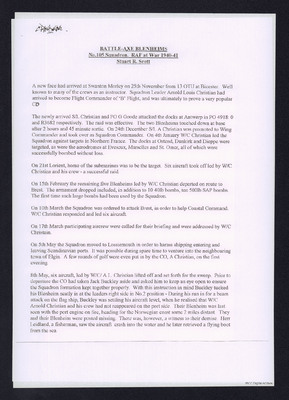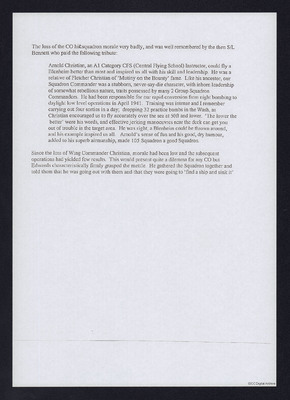Battle-Axe Blenheims
Title
Battle-Axe Blenheims
No 105 Squadron. RAF at War 1940-41
Description
An account of operations at the time Arnold took over as Flight Commander. He describes the operation when Arnold Christian was lost.
Creator
Spatial Coverage
Language
Format
Two printed sheets
Conforms To
Publisher
Rights
This content is available under a CC BY-NC 4.0 International license (Creative Commons Attribution-NonCommercial 4.0). It has been published ‘as is’ and may contain inaccuracies or culturally inappropriate references that do not necessarily reflect the official policy or position of the University of Lincoln or the International Bomber Command Centre. For more information, visit https://creativecommons.org/licenses/by-nc/4.0/ and https://ibccdigitalarchive.lincoln.ac.uk/omeka/legal.
Contributor
Identifier
SChristianAL29160v10050-0001, SChristianAL29160v10050-0002
Transcription
[inserted] [deleted] [indecipherable word] [/deleted] [/inserted]
[underlined] BATTLE-AXE BLENHEIMS
NO. 105 Squadron. RAF at War 1940-41
Stuart R. Scott [/underlined]
A new face had arrived at Swanton Morley on 25th November from 13 OTU at Bicester. Well known to many of the crews as an instructor. Squadron Leader Arnold Louis Christian had arrived to become Flight Commander of ‘B’ Flight, and was ultimately to prove a very popular CO
The newly arrived S/L Christian and PO G Goode attacked the docks at Antwerp in PO 4918: 0 and R3682 respectively. The raid was effective. The two Blenheims touched down at base after 2 hours and 45 minute sortie. On 24th December S/L A Christian was promoted to Wing Commander and took over as Squadron Commander. On 4th January W/C Christian led the Squadron against targets in Northern France. The docks at Ostend, Dunkirk and Dieppe were targeted, as were the aerodromes at Eveseux, Marselles [sic] and St. Omer, all of which were successfully bombed without loss.
On 21st Lorient, home of the submarines was to be the target. Six aircraft took off led by W/C Christian and his crew – a successful raid.
On 15th February the remaining five Blenheims led by W/C Christian departed on route to Brest. The armament dropped included, in addition to 10 40lb bombs, ten 500lb SAP bombs. The first time such large bombs had been used by the Squadron.
On 10th March the Squadron was ordered to attack Brest, in order to help Coastal Command. W/C Christian responded and led six aircraft.
On 17th March participating aircrew were called for their briefing and were addressed by W/C Christain. [sic]
On 5th May the Squadron moved to Lossiemouth in order to harass shipping entering and leaving Scandinavian ports. It was possible during spare time to venture into the neighbouring town of Elgin. A few rounds of golf were even put in by the CO, A Christian, on the first evening.
8th May, six aircraft, led by W/C/ A.L. Christian lifted off and set forth for the sweep. Prior to departure the CO had taken Jack Buckley aside and asked him to keep an eye open to ensure the Squadron formation kept together properly. With this instruction in mind Buckley tucked his Blenheim neatly in at the leaders right side in No. 2 position – During his run in for a beam attack on the flag ship, Buckley was settling his aircraft level, when he realised that W/C Arnold Christian and his crew had not reappeared on the port side. Their Blenheim was last seen with the port engine on fire, heading for the Norwegian coast some 2 miles distant. They and their Blenheim were posted missing. There was, however, a witness to their demise. Herr Leidland, a fisherman, saw the aircraft crash into the water and he later retrieved a flying boot from the sea.
[page break]
The loss of the CO hit squadron morale very badly, and was well remembered by the then S/L Bennett who paid the following tribute:
Arnold Christian, an A1 Category CFS (Central Flying School) Instructor, could fly a Blenheim better than most and inspired us all with his skill and leadership. He was a relative of Fletcher Christian of ‘Mutiny on the Bounty’ fame. Like his ancestor, our Squadron Commander was a stubborn, never-say-die character, with inborn leadership of somewhat rebellious nature, traits possessed by many 2 Group Squadron Commanders. He had been responsible for our rapid conversion from night bombing to daylight low level operations in April 1941. Training was intense and I remember carrying out four sorties in a day; dropping 32 practice bombs in the Wash, as Christian encouraged us to fly accurately over the sea at 50ft and lower. ‘The lower the better’ were his words, and effective jerking manoeuvres near the deck can get you out of trouble in the target area. He was right, a Blenheim could be thrown around, and his example inspired us all. Arnold’s sense of fun and his good, dry humour, added to his superb airmanship, made 105 Squadron a good Squadron.
Since the loss of Wing Commander Christian, morale had been low and the subsequent operations had yielded few results. This would present quite a dilemma for any CO but Edwards characteristically firmly grasped the mettle. He gathered the Squadron together and told them that he was going out with them and that they were going to ‘find a ship and sink it’
[underlined] BATTLE-AXE BLENHEIMS
NO. 105 Squadron. RAF at War 1940-41
Stuart R. Scott [/underlined]
A new face had arrived at Swanton Morley on 25th November from 13 OTU at Bicester. Well known to many of the crews as an instructor. Squadron Leader Arnold Louis Christian had arrived to become Flight Commander of ‘B’ Flight, and was ultimately to prove a very popular CO
The newly arrived S/L Christian and PO G Goode attacked the docks at Antwerp in PO 4918: 0 and R3682 respectively. The raid was effective. The two Blenheims touched down at base after 2 hours and 45 minute sortie. On 24th December S/L A Christian was promoted to Wing Commander and took over as Squadron Commander. On 4th January W/C Christian led the Squadron against targets in Northern France. The docks at Ostend, Dunkirk and Dieppe were targeted, as were the aerodromes at Eveseux, Marselles [sic] and St. Omer, all of which were successfully bombed without loss.
On 21st Lorient, home of the submarines was to be the target. Six aircraft took off led by W/C Christian and his crew – a successful raid.
On 15th February the remaining five Blenheims led by W/C Christian departed on route to Brest. The armament dropped included, in addition to 10 40lb bombs, ten 500lb SAP bombs. The first time such large bombs had been used by the Squadron.
On 10th March the Squadron was ordered to attack Brest, in order to help Coastal Command. W/C Christian responded and led six aircraft.
On 17th March participating aircrew were called for their briefing and were addressed by W/C Christain. [sic]
On 5th May the Squadron moved to Lossiemouth in order to harass shipping entering and leaving Scandinavian ports. It was possible during spare time to venture into the neighbouring town of Elgin. A few rounds of golf were even put in by the CO, A Christian, on the first evening.
8th May, six aircraft, led by W/C/ A.L. Christian lifted off and set forth for the sweep. Prior to departure the CO had taken Jack Buckley aside and asked him to keep an eye open to ensure the Squadron formation kept together properly. With this instruction in mind Buckley tucked his Blenheim neatly in at the leaders right side in No. 2 position – During his run in for a beam attack on the flag ship, Buckley was settling his aircraft level, when he realised that W/C Arnold Christian and his crew had not reappeared on the port side. Their Blenheim was last seen with the port engine on fire, heading for the Norwegian coast some 2 miles distant. They and their Blenheim were posted missing. There was, however, a witness to their demise. Herr Leidland, a fisherman, saw the aircraft crash into the water and he later retrieved a flying boot from the sea.
[page break]
The loss of the CO hit squadron morale very badly, and was well remembered by the then S/L Bennett who paid the following tribute:
Arnold Christian, an A1 Category CFS (Central Flying School) Instructor, could fly a Blenheim better than most and inspired us all with his skill and leadership. He was a relative of Fletcher Christian of ‘Mutiny on the Bounty’ fame. Like his ancestor, our Squadron Commander was a stubborn, never-say-die character, with inborn leadership of somewhat rebellious nature, traits possessed by many 2 Group Squadron Commanders. He had been responsible for our rapid conversion from night bombing to daylight low level operations in April 1941. Training was intense and I remember carrying out four sorties in a day; dropping 32 practice bombs in the Wash, as Christian encouraged us to fly accurately over the sea at 50ft and lower. ‘The lower the better’ were his words, and effective jerking manoeuvres near the deck can get you out of trouble in the target area. He was right, a Blenheim could be thrown around, and his example inspired us all. Arnold’s sense of fun and his good, dry humour, added to his superb airmanship, made 105 Squadron a good Squadron.
Since the loss of Wing Commander Christian, morale had been low and the subsequent operations had yielded few results. This would present quite a dilemma for any CO but Edwards characteristically firmly grasped the mettle. He gathered the Squadron together and told them that he was going out with them and that they were going to ‘find a ship and sink it’
Collection
Citation
Stuart Scott, “Battle-Axe Blenheims,” IBCC Digital Archive, accessed June 1, 2024, https://ibccdigitalarchive.lincoln.ac.uk/omeka/collections/document/36328.
Item Relations
This item has no relations.


